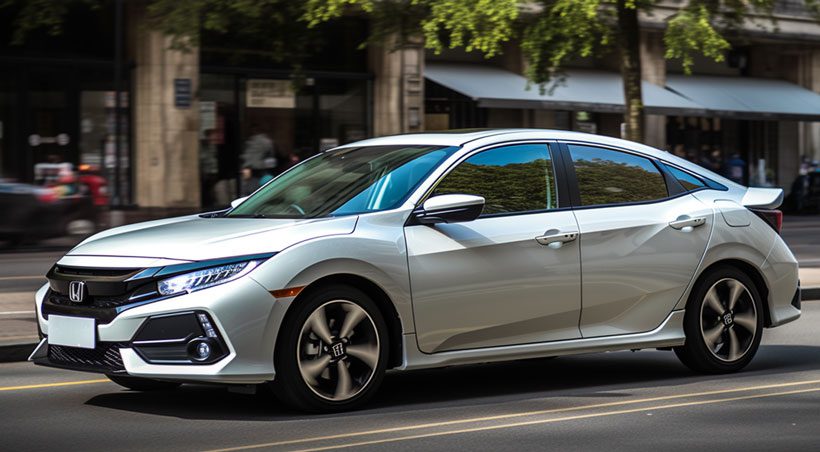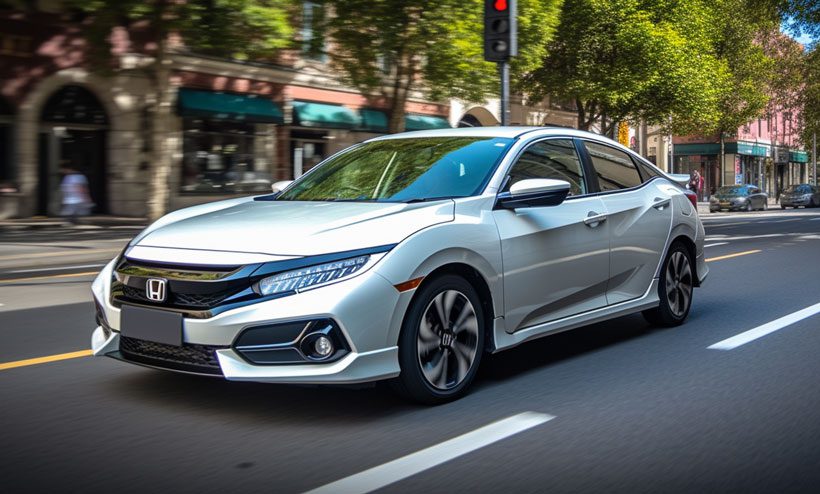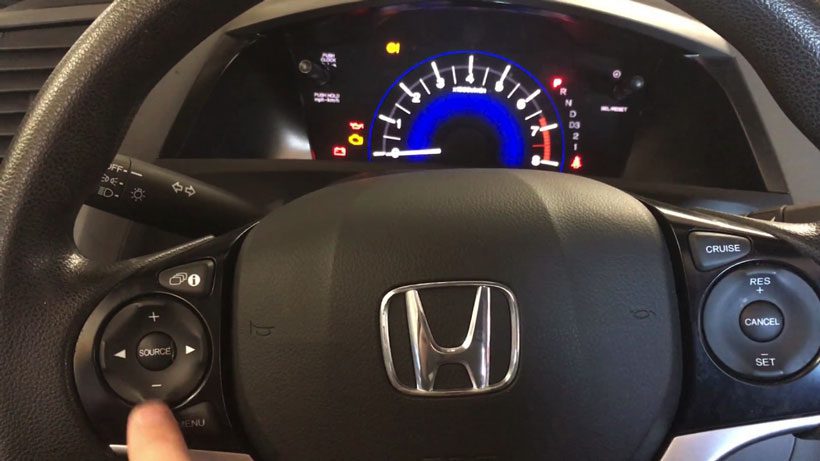Honda Civic ABS Light On: Common Causes and How to Reset
As with any complex system, the ABS may encounter issues in your Honda Civic from time to time. To address the issue, first, you must understand the causes promptly.
So, why is the Honda Civic ABS light on? Issues with the following components are the main reasons to turn on the ABS light in Honda Civic.
- The wheel speed sensors
- ABS control module
- Brake fluid level
- ABS pump
- Wiring/electrical problems
To maintain the highest level of driving safety, it is essential to make sure the ABS system is working properly. This article aims to guide Honda Civic owners to address ABS-related concerns effectively. So, keep reading.
Common Causes of Honda Civic ABS Light On With Solutions

Owners of Honda Civics will be better able to detect and fix issues by being aware of these probable reasons.
Faulty Wheel Speed Sensor
The wheel speed sensors are essential components of the ABS. It keeps track of each wheel’s rotational speed. But road debris damage, electrical problems, or sensor misalignment are some reasons for sensor dysfunction.
Therefore, the ABS light will illuminate if the ABS system is unable to detect wheel lock-up correctly due to a malfunctioning wheel speed sensor.

Solution:
To address a faulty wheel speed sensor causing the ABS light to illuminate:
- Scan the ABS system for error codes to identify the malfunctioning sensor.
- Inspect the sensor for damage or debris and clean it.
- Check the wiring and connections for faults and repair as needed.
- Align the sensor properly with the wheel’s tone ring.
- Test the sensor using a diagnostic tool to ensure proper functionality.
- Replace the sensor if it fails the test or continues to malfunction.
- Clear error codes and test the ABS system for proper functioning.
Low Tire Pressure
The ABS light in a Honda Civic may come on due to low tire pressure. When tire pressure is too low, it can affect wheel rotation speed and trigger an imbalance in ABS sensor readings.

Solution:
To resolve it, check tire pressure, inflate according to the manual, and reset the TPMS. If the light persists, consult a mechanic for further diagnosis.
To reset the TPMS, follow the steps below.
- Check tire pressure and inflate according to the manual.
- Locate the TPMS reset button (refer to the manual).
- Turn on the ignition without starting the engine.
- Press and hold the TPMS reset button until the TPMS light blinks.
- Release the reset button.
- Wait for the TPMS light to turn off (it may take a few minutes).
- If the light persists, consult a mechanic for further diagnosis.
ABS Control Module Issues
The ABS control module is the central component that manages the ABS’s operation. But sometimes, electrical issues, software bugs, or physical damage can all result in ABS control module issues.
And a Malfunctioning ABS control module can result in the ABS light turning on and may affect the overall functionality of the ABS.
Solution
To address ABS control module issues causing the ABS light to turn on and affect ABS functionality:
- Check electrical connections and repair any issues.
- Reset the ABS control module by disconnecting and reconnecting the battery.
- Perform a diagnostic scan to identify specific error codes or problems.
- Update the module’s software if available.
- Consult a professional for repair or replacement if necessary.
- Clear error codes and test the ABS system for proper functionality.
Low Brake Fluid Level
The ABS must have enough brake fluid to function properly. Leaks, worn brake pads, or incorrect maintenance are the three primary reasons for low brake fluid levels.
So, the ABS light may turn on when the brake fluid level falls below the necessary threshold.

Solution
To address a low brake fluid level causing the ABS light to turn on, go through the following steps.
- Check the brake fluid level and refill if low.
- Inspect for leaks in the brake system and repair any found.
- Check brake pad wear and replace it if necessary.
- Bleed the brake system to remove air if needed.
- Verify proper brake fluid level and test ABS functionality.
- If the issue persists, seek professional assistance for further diagnosis and repair.
ABS Pump Failure
The ABS pump helps to modulate braking pressure when the ABS is activated by pressurizing the brake fluid inside the ABS system. Mechanical flaws, electrical issues, or aging can all lead to ABS pump failure.
And the performance of the ABS will be hampered by an inoperable ABS pump, which will cause the ABS light to come on.
Solution
To address ABS pump failure causing the ABS light to come on:
- Check fuses and relays related to the ABS system.
- Ensure secure electrical connections to the ABS pump.
- Perform a diagnostic scan to identify the specific issue.
- Seek professional repair or replacement of the ABS pump.
- Clear error codes and test the ABS system for proper functionality.
Wiring and Electrical Issues
The communication and operation of the ABS depend on a web of wire and electrical parts. The ABS light may come on if there are electrical issues that affect how the ABS operates.
Solution:
- Change the frayed or broken wires.
- Tighten the loose connections.
- Clean the corroded terminals.
How to Reset the ABS Light in a Honda Civic?

By following the proper precautions, understanding the reset procedure, and addressing the underlying cause, you, too, can effectively reset the ABS light.
Precautions and Considerations Before Resetting the ABS Light
Keep in mind the following safety advice and concerns before attempting to reset the ABS light on a Honda Civic:
- Make sure the root cause of the ABS light illumination has been located and fixed.
- To prevent any damage to the vehicle or personal injury, use caution and pay close attention to the directions.
- It is advised to seek expert guidance if you are unsure of how to complete the reset operation or feel uncomfortable doing so.
Step-by-Step Guide to Resetting the ABS Light

A regular step-by-step procedure for turning off the ABS light on a Honda Civic is provided below:
- Step 1: Locate the diagnostic connector: The diagnostic connector is typically located under the dashboard on the driver’s side. For the exact location, see the owner’s handbook or other references.
- Step 2: Connect an OBD-II scanner to the diagnostic connector: Connect an OBD-II scanner that is compatible with the diagnostic connection.
- Step 3: Access ABS codes and reset the light: Obtain the ABS codes from the scanner. Resolve the issues of the ABS light on. After resolving the underlying issues, reset the ABS light by clearing the codes.
If uncertain about resetting or the issue persists, it is advisable to consult a qualified mechanic or visit a Honda dealership. Auto repair shops equipped with specialized diagnostic tools and expertise can diagnose the ABS. They can identify the specific problem and reset the ABS light effectively.
To guide you better, here’s a Youtube video!
FAQs
Let’s see what people also ask for when they look into solutions for Honda Civic ABS Light on.
Yes. Although driving a Honda Civic with the ABS light on is theoretically possible, it is not advised. The ABS light suggests that there may be a problem with the ABS, which might endanger the safety and effectiveness of your car’s braking system.
The complexity of the ABS system requires advanced automotive knowledge and specialized tools for proper diagnosis and repair. While you can try basic troubleshooting, it is often best to consult a professional mechanic or visit a Honda dealership.
Conclusion
A Honda Civic’s ABS light is an important warning indication that must not be disregarded. Owners of Honda Civics may find and fix any problems with the ABS system by identifying the causes, which can guarantee their safety while driving.
Remember that maintaining the highest level of safety while driving necessitates the ABS’s correct operation. To ensure a safe and comfortable driving experience, keep a proactive approach to car maintenance and seek expert assistance when necessary. Maintain vigilance and put safety first.

